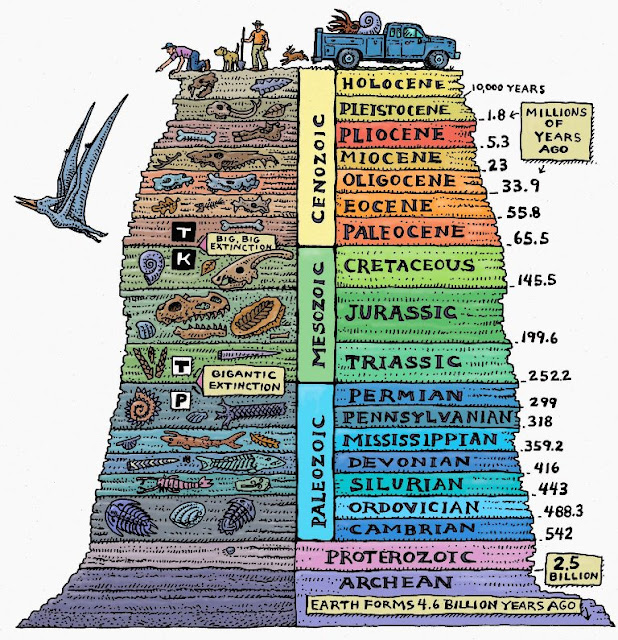The Long Life of Earth 9/10
 |
| https://www.geologyin.com/2016/12/10-interesting-facts-about-geological.html In the text book the Pennsylvanian and Mississippian times are replaced with the Carboniferous section, but due to later research, I learned that those are both parts of the Carboniferous time period. Fun fact, the Pennsylvanian period is also known as Upper Carboniferous or Late Carboniferous. Like you said, these eras are divided into sections and those sections are divided down to make it easier to understand, and because it consumed so much time. |
Summary:
The geologic time scale is a record of all life forms that ever roamed the Earth, as well as geological events in Earth's history. Relative age in the sense of rocks is the age of a rock in comparison to another whereas absolute age is the number of years since that particular rock was formed. Radiometric dating can allow scientists to analyze rocks and determine their absolute age. The Law of Superposition states that new rock is placed over the old rock. Using absolute age we can tell that the top layer of rock is always newer or younger than the bottom layer. Fossils that are buried inside layers of rock can help scientists determine the absolute age of the rock This gives them a better estimate of the age of rocks on top and beneath. All this helped scientists create the geologic time scale and if you look closer you can see it is divided into sections that are then divided more. They are divided based on significant events that occurred during that time. The Mesozoic Era is compromised of three portions that make up dinosaur evolution, from when they begin to raom the Erath to their mass extinction.
S&EP-Constructing explanations and designing solutions:
This week was a lot of independent work even though we were all working on our group project. We each had our own part of the geologic time scale to research on. For me, that was the Mesozoic era, filled with dinosaurs, birds, and flowering plants. We all had a research sheet that we had to complete, that had specific questions. Throughout this answering process, I had to construct explanations for certain events. An example of this would be when I explained what scientists think caused the mass extinction that killed off all the dinosaurs. Most scientists believe that a large object from space, such as an asteroid, hit Earth causing the death of multiple species. This may be true, although there is a theory that increased volcanic activity affected the climate which then played a role in this devastation. Along with this, I got o practice my explanation skills this week which was useful.
XCC-Cause and Effect:
The planet that we live on is continuously changing at a steady rate from the animals that roam it to the shape and structure of the actual Earth. The Mesozoic Era was when a lot of changes happened, especially considering Pangea. All the land on Earth was once one supercontinent but now is split into several parts. What caused this major change? Well, the Earth's crust is made up of plates that are constantly moving at a steady rate from about 1/2 to 4 inches per year. This may not sound like a lot, but over time it adds up. The Continental Drift theory states that the continents are still moving the same way today and this Continental Drift is what caused Pangea to split up. This was extremely useful information because the slow action of Pangea splitting (due to moving plates) acted out over the course of the Mesozoic Era.
Multiplier:
This week I was a mutant, to be more specific a creator because when we researched for the project I shared interesting and helpful information with my teammates.


Comments
Post a Comment